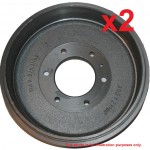There are several things to check your Brake Drums for when inspecting your brake system.
These are as follows:
Out of round or egg-shaped
This is caused by heating and cooling during braking. Mostly it will occur with the rear drums and caused by parking brake application preventing and expanded hot drum from contracting. Brake roughness or pedal pulsation will be visible, turn out or replace drum.
Scored surface
Caused by sand or grit, in the brake assembly or by very hard inferior grade lining. If the grooves are less than 0.010” they drum may be turned.
Bell mouthed
Mostly occurs on wide drums not being supported enough at the outer diameter of the drum. Proper drum to lining contact cannot be achieved and fading can be expected. Turn out or replace drum.
Hard spots
A change in metallurgy caused by braking heat. Pedal pulsations, pulling, chatted, hard pedal, rapid wear and noise will occur. If the spots are severe, the drum must be replaced. Turing out minor spots only treats the surface and can reappear when heat is applied.
Cracks
Fine cracks at the bolt circle or outside flange may be difficult to see and may not be found until the drum has been turned. Replace drum if cracks appear.
Threaded drum surface
This is caused by using a very sharp or chipped tool when turning the drum. A clicking or snapping sound will be heard during braking.
Measuring
Measure brake drums with a drum micrometer to see if they are within the safe oversize limits, then they can be turned.
If your brakes are noisy or aren’t stopping like they use to, visit your local mechanic to diagnose the problem.
Visit our Brake Parts category to see if we have the brake parts you require.


